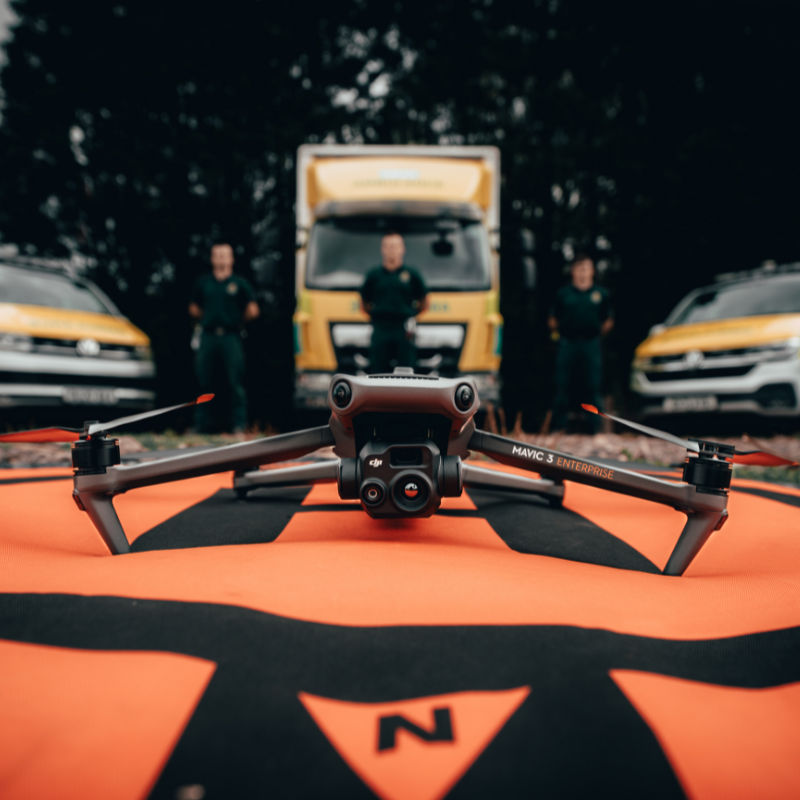
Products
DJI Mavic 3 Enterprise Series vs M30 vs M300 RTK
The Mavic 3 Enterprise Series, M30 Series, and M300 RTK make up DJI's premium enterprise drone line-up. Each platform has its distinct advantages and qualities: Find out which solution is best for your operations with our in-depth guide. ... Read More

The Mavic 3 Enterprise, M30 Series, and M300 RTK make up DJI's premium enterprise line-up. Find out which solution is best for your operations;
Choosing the best platform depends on numerous factors, including use case and budget;
The Mavic 3 Enterprise Series is a compact, lightweight and portable solution for surveying, inspection and public safety. These cost-effective drones are great entry-level aircraft and ideal for rapid deployment - however, they do lack some features, such as an IP rating;
The M30 Series is a fine blend of power, portability and performance. As DJI's most weather-proof solution to date, it is particularly suited to public safety operations. Its lack of survey-optimised camera makes it unsuitable for drone mapping;
The M300 RTK is the largest and most costly platform in DJI's enterprise line-up, but for the added price, you gain DJI's most versatile aircraft, compatible with a library of top-class payloads including zoom, thermal, night vision, photogrammetry, LiDAR, spotlights, speakers, gas detection modules, and agricultural sensors.
DJI strengthened its enterprise line-up with the release of the Mavic 3 Enterprise Series.

These drones - namely the Mavic 3E and Mavic 3T - join the M30 Series and M300 RTK as DJI's premium commercial platforms.
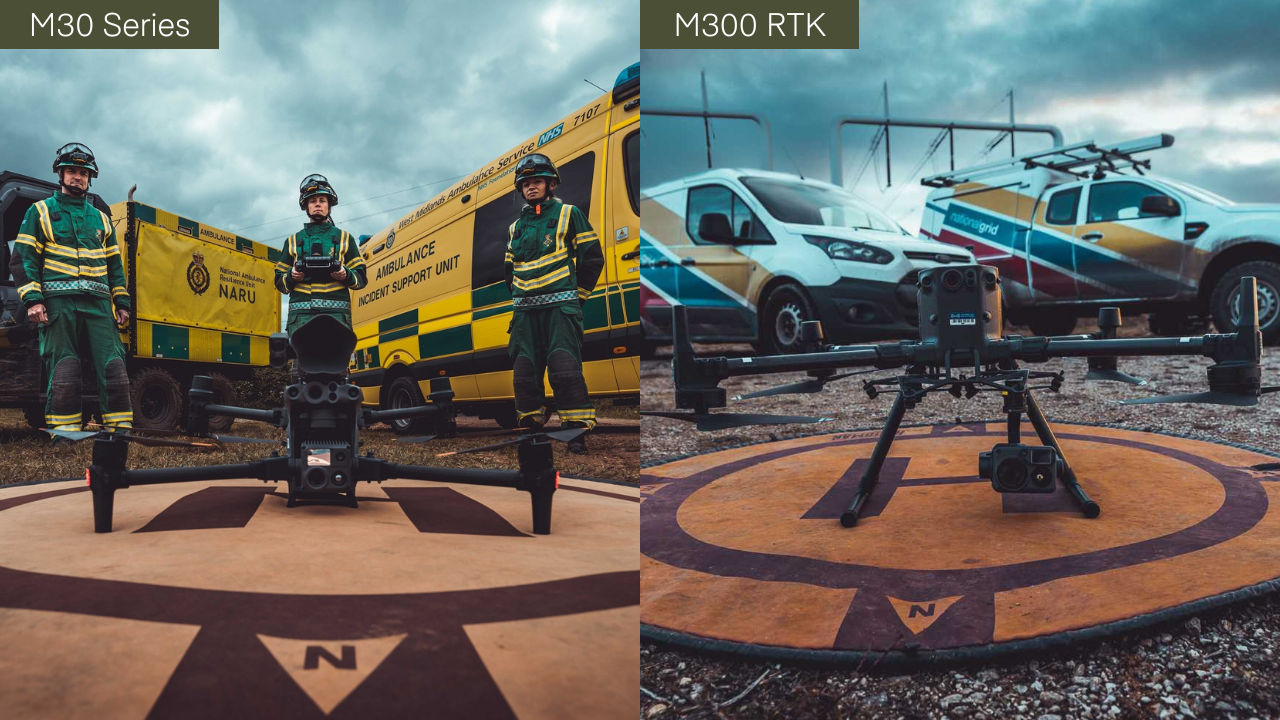
Each aircraft has its own specific user profile, from the compact and lightweight Mavic 3 Enterprise Series through to the flagship M300 RTK with its unrivalled versatility.
Which one you choose depends on numerous factors, such as use case and budget.
This blog takes a look at all of these solutions - highlighting their key specifications and best applications - to help you make an informed choice on the optimal platform for your specific requirements.
Key Specifications
This table provides an at-a-glance overview of the key specifications of the Mavic 3 Enterprise Series (Mavic 3E and Mavic 3T), M30 Series (M30 and M30T) and M300 RTK.
Mavic 3 Enterprise Series (Mavic 3E and Mavic 3T) | M30 Series (M30 and M30T) | M300 RTK | |
Dimensions (L x W x H) | Folded (without propellers): 221 x 96.3 x 90.3 mm; Unfolded (without propellers): 347.5 x 283 x 107.7 mm | Folded: 365 x 215 x 195 mm; Unfolded (propellers excluded): 470 x 585 x 215 mm | Folded: 430 x 420 x 430 mm; Unfolded (propellers excluded): 810 x 670 x 430 mm |
Weight | DJI Mavic 3E: 915 g; DJI Mavic 3T: 920 g (without propellers and accessories) | 3.7 kg (including two batteries) | Approx. 6.3 kg (with two TB60 batteries, and single downward gimbal) |
Max Take-off Weight | DJI Mavic 3E: 1,050 g; DJI Mavic 3T: 1,050 g PSDK supported | 4 kg PSDK supported | 9 kg PSDK supported |
Max Flight Time | 45 minutes | 41 minutes | 55 minutes (no payload); With payload: Depends on payload. Examples include H20T: 43 min; P1: Up to 44 min; L1: Up to 42 min. |
Camera/Payloads | Fixed, multi-sensor payload. Mavic 3E: Wide + Tele; Mavic 3T: Wide + Tele + Thermal. Accessories can be added, such as RTK Module and loudspeaker. | Fixed, multi-sensor payload. M30: Laser rangefinder + Wide + Zoom; M30T: Laser rangefinder + Wide + Zoom + Thermal. Third-party payloads, such as LP12 loudspeaker and spotlight, can also be used | Interchangeable payloads, including third-party payloads. Can carry up to three at a time. Payload options include H20T (Laser rangefinder + Wide + Zoom + Thermal); P1 full-frame photogrammetry camera; L1 LiDAR and photogrammetry sensor; gas detection modules; speakers/spotlights; and agricultural sensors. |
IP Rating | No | IP55 | IP45 |
Operating Temperature | -10°C to 40°C | -20°C to 50°C | -20°C to 50°C |
Max Speed | 15 m/s (Normal Mode); Forward: 21 m/s (Sport Mode) | 23 m/s | S mode: 23 m/s P mode: 17 m/s |
Max Wind Speed Resistance | 12 m/s (during take-off and landing) | 15 m/s; 12 m/s (during take-off and landing) | 15 m/s; 12 m/s (during take-off and landing) |
RTK | Supported (RTK Module to be purchased separately) | Supported (Dual RTK Built in) | Supported (Dual RTK Built in) |
Controller | DJI RC Pro Enterprise (No IP rating) | DJI RC Plus (IP54 rated) | DJI Smart Controller Enterprise; No IP Rating *RC Plus compatibility is expected soon |
Max Transmission Distance (CE) | 8km | 8 km | 8 km |
Dual RC Control Mode | Not supported | Supported | Supported |
Safety Features | Includes omnidirectional binocular vision system; DJI AirSense; Smart Return To Home; APAS 5.0; Health Management System. | Includes omnidirectional sensing; DJI AirSense; Smart Return To Home; Three Propeller Landing; Health Management System. | Includes omnidirectional sensing; DJI AirSense; Smart Return To Home; Three Propeller Landing; Health Management System. |
Suggested Industries | Mavic 3E: Precision surveying and inspection; Mavic 3T: Public safety, thermal mapping, inspection. | Public safety, inspection. Use the M30T when thermal data is required. | Depends on the payload, but M300 RTK has a solution for all industry verticals, including public safety, inspection, surveying, and agriculture. |
Price Bracket | Low tier | Mid tier | High tier |
Mavic 3 Enterprise vs M30 Series vs M300 RTK: Design
The design characteristics of the Mavic 3 Enterprise Series, M30 Series and M300 RTK can play a big part in deciding which platform is best suited to your operations.
Size, weight and the type of payload capabilities are key elements in this department.
Size and Weight
In terms of footprint, the Mavic 3 Enterprise Series is significantly lighter and smaller than the others. Indeed, this compact platform is particularly useful for public safety and search and rescue crews, when it is imperative to get eyes on an incident as soon as possible.

Next on the size scale is the M30 Series - which has a similar body to the M300 RTK, but in a smaller frame. While it isn't as portable and lightweight as the Mavic 3 Enterprise Series, it is still small enough to fit in a backpack - providing a perfect balance between power and portability.
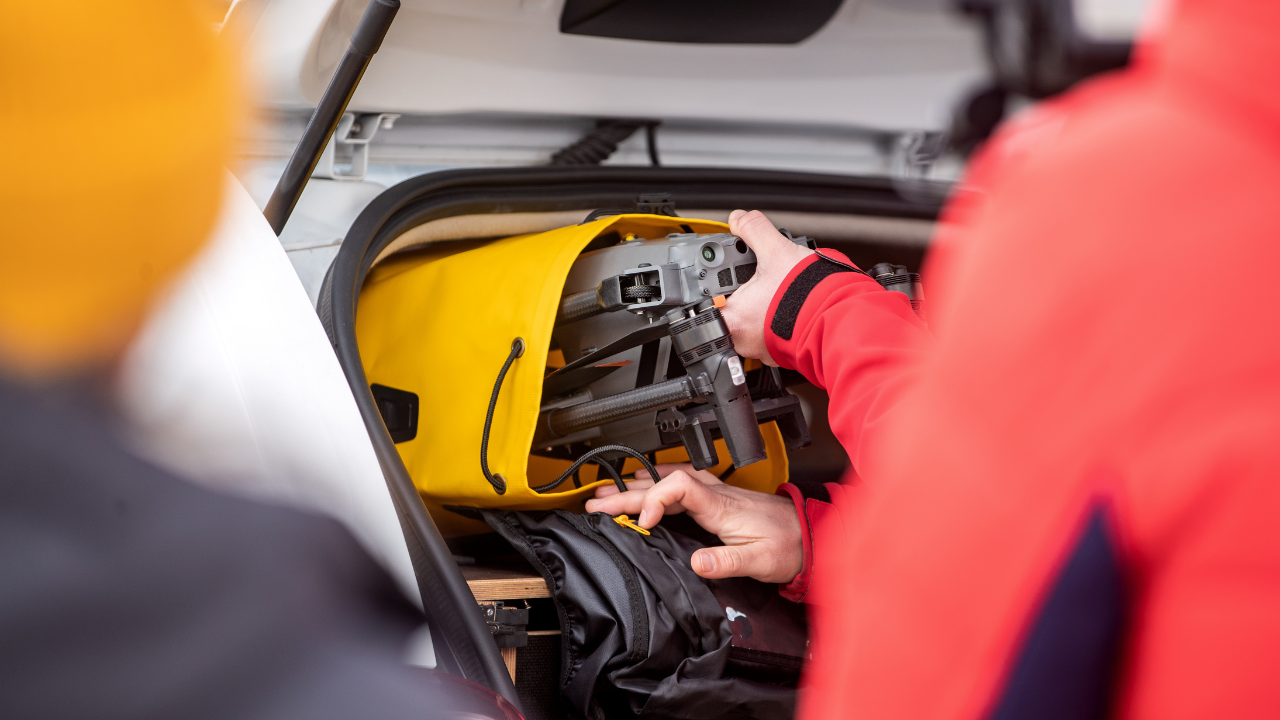
The M300 RTK is a far more substantial aircraft. It can still be deployed in less than two minutes, but it lacks the highly-portable nature of the other two.

That said, its size enables it to carry a substantial amount of weight - with a maximum take-off weight of 9kg - and can integrate up to three payloads at a time.
Mavic 3 Enterprise Series | M30 Series | M300 RTK | |
Dimensions (L x W x H) | Folded (without propellers): 221 x 96.3 x 90.3 mm; Unfolded (without propellers): 347.5 x 283 x 107.7 mm | Folded: 365 x 215 x 195 mm; Unfolded (propellers excluded): 470 x 585 x 215 mm | Folded: 430 x 420 x 430 mm; Unfolded (propellers excluded): 810 x 670 x 430 mm |
Weight | DJI Mavic 3E: 915 g DJI Mavic 3T: 920 g (without propellers and accessories) | 3.7 kg (including two batteries) | Approx. 6.3 kg (with two TB60 batteries, and single downward gimbal) |
Max Take-off Weight | DJI Mavic 3E: 915 g DJI Mavic 3T: 920 g (without propellers and accessories) | 4kg | 9kg |
Cameras/Payloads
Payloads and cameras will be discussed in more detail later in this article, but the Mavic 3 Enterprise Series, M30 Series, and M300 RTK have different payload configurations and capabilities.
The Mavic 3 Enterprise Series has a fixed, multi-sensor camera. Optimised for surveying, the Mavic 3E has a wide camera and a tele camera, while the Mavic 3T features a thermal camera, as well as a wide camera and tele camera. The Mavic 3E is below, left, while the Mavic 3T is below, right.

Accessories such as an RTK Module or loudspeaker, can be attached to the top of the aircraft.

It is a similar story for the M30 Series, which has a fixed, multi-sensor camera. The M30 has a wide, zoom and laser rangefinder, while the M30T - pictured below - matches the M30, but with the addition of a thermal sensor.

The M30 Series can also carry a third-party payload via its top port, such as the LP12 loudspeaker and spotlight.

In contrast, the M300 RTK has no fixed payload: Rather, it can be integrated with a vast library of cameras and sensors - including LiDAR, photogrammetry, zoom, wide and thermal - as well as other accessories, such as spotlights, loudspeakers, gas detection modules, night vision, and agricultural sensors.

As mentioned previously, the M300 RTK can carry up to three payloads at once, utilising these configurations: Single downward gimbal; Dual downward gimbals; Single upward gimbal; Upward and downward gimbals; Triple gimbals.
It makes the M300 RTK the most versatile DJI aircraft - and ideally suited to scaling as your business case evolves - which could be a major appeal to some operators.
Mavic 3 Enterprise vs M30 Series vs M300 RTK: Cameras
As mentioned, the camera set ups for the Mavic 3 Enterprise, M30 Series and M300 RTK are different.
To help review the cameras in more detail, and make them relevant to each operator, we will explore the payloads by application, highlighting each drone/sensor relevant to a specific use case.
These use cases will include RGB photogrammetry, thermal missions and visual data collection for operations such as public safety and inspection.
Best DJI Drone For Survey-grade RGB Photogrammetry
Drone surveying has become a major UAS application.
When it comes to DJI's survey-grade RGB photogrammetry solutions, there are three principle options: The Mavic 3 Enterprise; M300 RTK and Zenmuse P1; and the M300 RTK and Zenmuse L1.
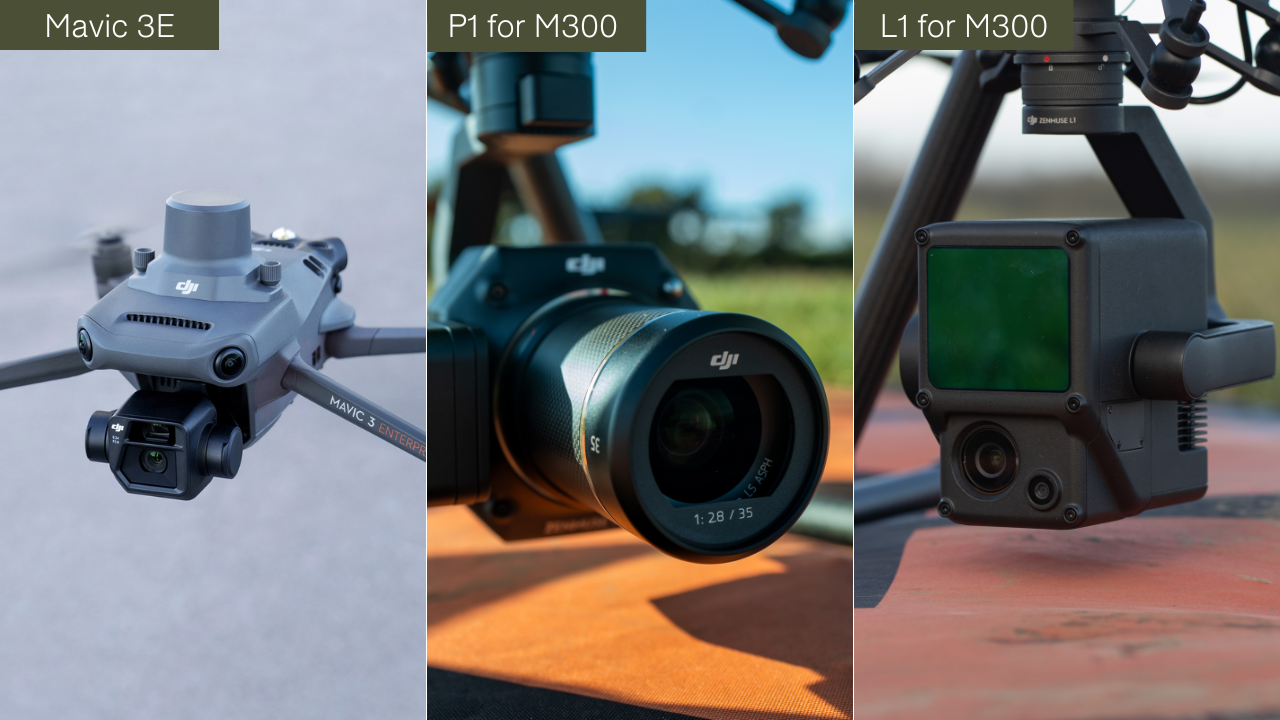
heliguy™ does not suggest using the M30 Series for this application.
The DJI Phantom 4 RTK is also an option but it has been replaced as DJI's main compact surveying solution by the Mavic 3 Enterprise, which trumps it in flight time, sensor size, portability and price.
For this reason, we have not included the P4 RTK in this comparison. However, read our Mavic 3 Enterprise vs P4 RTK blog for an in-depth comparison between these two compact mapping drones.
The table below provides an overview of the Mavic 3E, M300 RTK and P1, and M300 RTK and L1 for survey-grade RGB photogrammetry.
Mavic 3 Enterprise with RTK Module (Wide Camera) | M300 RTK + Zenmuse P1 | M300 RTK + Zenmuse L1 | |
Surveying Grade | Yes | Yes | Yes |
RTK/PPK Support | Yes | Yes | Yes |
GSD (cm) | H(m)/36.5 | 24mm: H(m)/55 35mm: H(m)/80 50mm: H(m)/120 | H(m)/36.5 |
Sensor Size | 4/3": 5280 × 3956 (4:3) | Full-frame (35.9×24mm): 8192 × 5460 (3:2) | 1"; 5472 × 3648 (3:2) |
Still Resolution | 20MP | 45MP | 20MP |
Pixel Size | 3.3μm | 4.4μm | 2.4μm |
Lens Option | 12mm/24mm Equivalent: FOV 84.0° | P1 has interchangeable lenses: DL 24mm; FOV 84.0°; DL 35mm; FOV 63.5°; DL 50mm; FOV 46.8° | 8.8mm/24mm Equivalent: FOV 84.0° |
Mechanical Shutter | Yes (1/2000-8s) | Yes (1/2000-1s) | Yes (1/2000-8s) |
Minimum Photo Interval | 0.7s | 0.7s | 2.5s |
Flight Time | Up to 42 mins (With RTK Module) | Up to 44 mins | Up to 42 mins |
Memory Requirement | microSD UHS-I Speed Grade 3 rating or above Max Capacity: 512GB | SD UHS-I rating or above Max Capacity: 512GB | microSD UHS-I Speed Grade 3 rating or above Max Capacity: 256GB |
Smart Oblique Support | (Support Planned) | Yes | No |
Real-time Terrain Follow | (Support Planned) | No | No |
All three solutions are survey-grade photogrammetry solutions that can achieve centimetre-level accuracy at a scale of 1:500 without installing site ground controls.
As a result, these products can effectively increase the efficiency of mapping and surveying work compared to other non-survey-optimised drones lacking RTK/PPK and DJI TimeSync support.
It's worth noting that the M300 RTK has a built-in RTK module, while Mavic 3 Enterprise operators will need to purchase the RTK module separately to achieve centimetre accuracy. You can find out more about the Mavic 3 Enterprise's RTK module by reading our in-depth guide.

When comparing the capabilities of these three photogrammetry solutions, it's fair to say that the P1 outperforms the M3E, which outperforms the L1.
This conclusion is made mainly because of the camera resolution, sensor size and pixel size; a high-resolution image can correspond to a high-resolution map or highly detailed model.

Larger pixels can ensure a better image's dynamic range and quality under low light conditions, leading to a more extended operation window on site.
In addition, the P1 provides multiple lens options for the user to select based on the flight scenario, whereas the L1 and Mavic 3 Enterprise have a fixed focal length with a fixed field of view.
The P1 can also fly higher to achieve the same GSD, increasing surveying efficiency.
However, there are some factors to consider.
Firstly, the L1 isn't principally a photogrammetry sensor: Rather, it is a LiDAR payload, with photogrammetry capabilities thrown in for good measure. In fact, the M300 RTK is the only drone which is able to capture LiDAR data.

So, for operators wanting LiDAR data sets, with the addition of photogrammetry, the L1 - as a dual mapping payload - is a great solution. Of course, operators could purchase the L1 and P1 for optimal LiDAR and photogrammetry data capture.
It's also worth noting that the M300 RTK can integrate with the GeoSLAM ZEB Horizon LiDAR scanner.

Secondly, the Mavic 3 Enterprise has a tele camera, as well as its survey-optimised wide camera. While not strictly beneficial for drone mapping, the tele sensor does enable operators to capture zoom data up to 56x hybrid zoom.
And on the Mavic 3 Enterprise Series front, the Mavic 3 Thermal can be used for mapping when using the RTK Module - although the accuracies won't be as precise as surveying with the Mavic 3E. However, the Mavic 3T can be used for collecting thermal mapping data, for instance.
The below table provides an overview of each DJI survey-grade RGB mapping solution, and their ideal user profile.
Matrice M300 RTK + Zenmuse P1 | Mavic 3 Enterprise | Matrice M300 RTK + Zenmuse L1 |
For customers who want the ultimate photogrammetry camera for effective reality capture and survey projects which require survey-level accuracy. | For customers who want a compact, quick-to-deploy reality capture solution for daily work with preferred survey-level accuracy. The Mavic 3T is ideal for those who want to conduct thermal mapping. | For customers who want an airborne LiDAR solution but need to do visible photogrammetry mapping projects that require survey-level accuracy. |
Mavic 3 Enterprise Series vs M30 Series vs M300 RTK: Public Safety and Inspection
The Mavic 3 Enterprise Series, M30 Series, and the M300 RTK are all reliable solutions for public safety and inspection.
In this section, we'll take a look at their cameras' ability to capture visual data, as well as thermal data (Mavic 3T, M30T, and M300 RTK with H20T).

Visual Data Collection
Mavic 3E | Mavic 3T | M30 Series (M30 & M30T) | M300 RTK + H20 Series (H20 + H20T) | |
Wide Camera | Sensor Size/Pixels 4/3 CMOS; 20 MP Lens FOV: 84° Format Equivalent: 24 mm Video Resolution 4K@30fps | Sensor Size/Pixels 1/2-inch CMOS; 48 MP Lens FOV: 84° Format Equivalent: 24 mm Video Resolution 4K@30fps | Sensor Size/Pixels 1/2" CMOS; 12MP Lens DFOV: 84° Focal length: 4.5 mm (equivalent: 24 mm) Video Resolution 4K/30fps | Sensor Size/Pixels 1/2.3" CMOS; 12 MP Lens DFOV: 82.9° Focal length: 4.5 mm (equivalent: 24 mm) Video Resolution 1080p@30fps |
Tele/Zoom Camera | Sensor 1/2-inch CMOS;12 MP Lens FOV: 15° Format Equivalent: 162 mm Video Resolution 4K@30fps | Sensor 1/2-inch CMOS;12 MP Lens FOV: 15° Format Equivalent: 162 mm Video Resolution 4K@30fps | Sensor 1/2" CMOS; 48MP Lens Focal length: 21-75 mm (equivalent: 113-405 mm) Video Resolution 4K/30fps | Sensor 1/1.7" CMOS; 20 MP Lens DFOV: 66.6°-4° Focal length: 6.83-119.94 mm (equivalent: 31.7-556.2 mm) Video Resolution 4K/30fps |
Visual Zoom Capabilities | Up to 56x hybrid | Up to 56x hybrid | 5x-16x Optical Zoom 200x Max. Hybrid Zoom | 23× Hybrid Optical Zoom, 200× Max Zoom |
Laser Rangefinder | Not supported | Not supported | Wave Length 905 nm Measurement Range 3-1,200 m (0.5×12 m vertical surface with 20% reflectivity) Measurement Accuracy ± (0.2 m + D×0.15%) D is the distance to a vertical surface | Wave Length 905 nm Measurement Range 3-1200 m (to a vertical surface with ≥12m diameter and 20% reflection rate) Measurement Accuracy ± (0.2 m + D×0.15%) D is the distance to a vertical surface |
High-resolution Grid Photo | Not supported | Not supported | Supported | Supported |
Thermal Data Collection
As well as visual data collection, the Mavic 3T, M30T, and M300 RTK and H20T are equipped with thermal sensors - ideal for missions such as search and rescue, firefighting and inspection.
The Mavic 2 Enterprise Advanced is another compact and lightweight thermal solution, but has been superseded by the Mavic 3T, which has enhanced flight time and greater visual capabilities, among other upgrades. As such, we will not include the M2EA in the comparison below, but you can find out how it stacks up against the Mavic 3 Thermal in our in-depth blog.
The table below showcases some of the key specifications of the thermal sensors on the Mavic 3T, M30T, and H20T.
Mavic 3T | M30T | H20T | |
Resolution | 640 x 512 | Infrared Image Super-resolution Mode: 1280 x 1024; Normal Mode: 640 x 512 | 640 x 512 |
Frame Rate | 30 Hz | 30 Hz | 30 Hz |
Lens | DFOV: 61°; Format Equivalent: 40 mm | DFOV: 61°; Focal length: 9.1 mm (equivalent: 40 mm) | DFOV: 40.6°; Focal length: 13.5 mm (equivalent: 58 mm) |
Photo Format | R-JPEG (16-bit) | R-JPEG (16 bit) | R-JPEG (16 bit) |
Scene Range | -20°C to 150°C (High Gain); 0°C to 500°C (Low Gain) | -20°C to 150°C (High Gain); 0°C to 500°C (Low Gain) | -40°C to 150°C (High Gain); -40°C to 550°C (Low Gain) |
Thermal Zoom | Up to 28x digital zoom | Up to 20x digital zoom | Up to 8x digital zoom |
Temperature Alert | Supported | Supported | Supported |
Isotherms | Supported | Supported | Supported |
Temperature Measurement | Spot Meter and Area Measurement | Spot Meter and Area Measurement | Spot Meter and Area Measurement |
Night Scene For Zoom Camera | Not supported | Supported | Supported |
The Mavic 3 Enterprise Series, M30 Series, and H20 Series are all multi-sensor payloads. With all of them come a suite of features including: Security Encryption, Panorama Mode, Live Mission Planning, and Quick View Switch between different cameras.
However, there are some key differences.
The Mavic 3 Enterprise Series lacks a laser rangefinder sensor. Because of this, it does not support the range measurement, and coordinate calculation features with DJI Pilot 2 and DJI FlightHub 2. Incidentally, the Mavic 3 Enterprise Series, M30 Series, and M300 RTK are compatible with FlightHub 2 - DJI's all-in-one cloud-based drone operations management platform.

The laser rangefinder is also used for smart-track, high-res grid, and focusing the visual zoom camera, which the Mavic 3 Enterprise Series lacks. However, the Mavic 3 Enterprise Series can drop 'pins' - but only at the location of the drone.
When comparing the Mavic 3 Enterprise Series, M30 Series, and H20 Series, the visual zoom of the H20 Series slightly outperforms the M30T, which then outperforms the Mavic 3 Enterprise Series.
The infrared modules are all very similar and have 640 x 512 resolution. The M30T does have a unique feature of upscaling infrared photos four times its original, making the image sharper, but this simply can be a bit nicer for the operators live view and does not affect the end-data.
Remember we said that the M300 RTK is a highly versatile aircraft: Well this means that, when it comes to thermal data collection, the drone can integrate with thermal solutions beyond the H20T, such as the FLIR Vue TZ20-R dual thermal zoom payload, and the IR10 infrared laser zoom spotlight night-vision payload.
It can also carry the DJI Zenmuse H20N night-vision sensor, complete with starlight visual sensors to provide outstanding low-light performance.
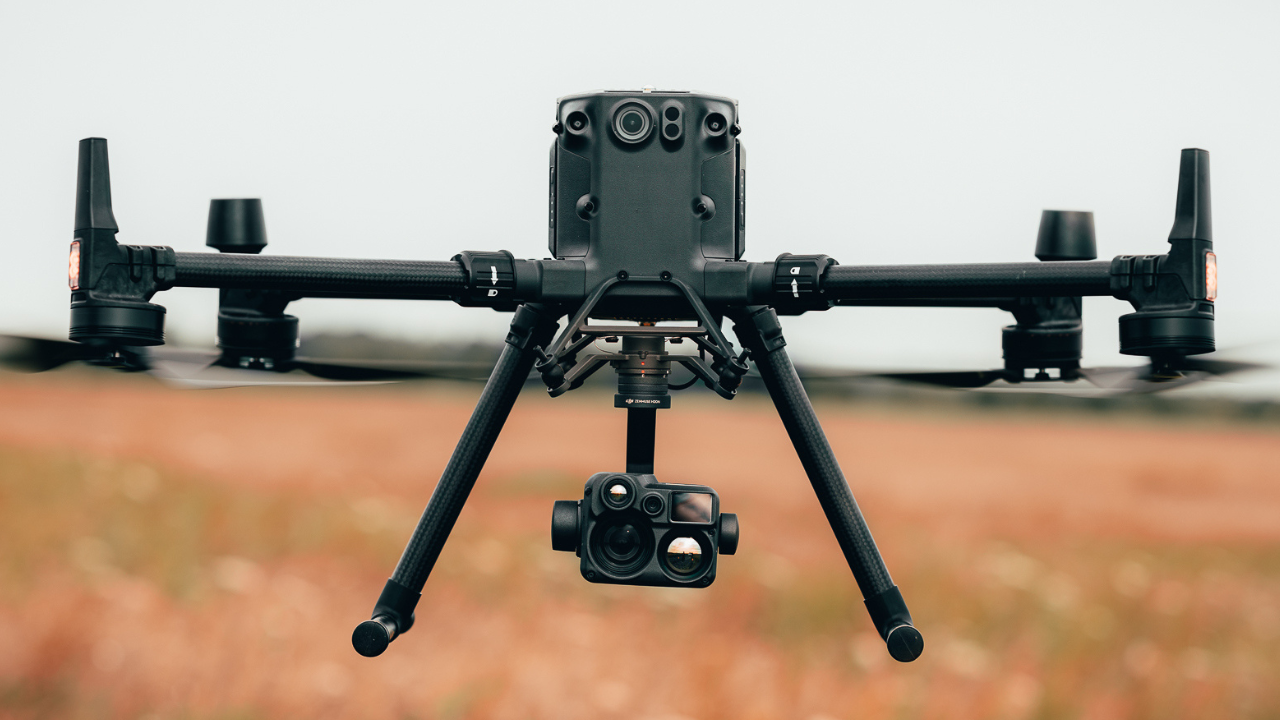
It's fair to say that this results in low-resolution photos - with solutions such as the M30T and H20T outperforming it for detailed visual inspection - and it is also not recommended for thermal inspections.
But this fusion sensor is explicitly designed to optimise the efficiency of nighttime operations while still performing well during the day for public safety.
The table below highlights the suggested user profile for each solution.
M300 + H20 Series | M30 Series | Mavic 3 Enterprise Series |
For inspection customers who want to utilise the highest resolution visual zoom camera for inspection photos alongside thermal data with the H20T. | For public safety and inspection customers who require a quick-to-deploy and fairly portable system with greater visual zoom capability and flagship enterprise features that are lacking in the entry level system, which leads to better data collection and ability to operate in tougher conditions. | Entry level portable drone (with the Mavic 3T offering a quality thermal solution) with longer flight time and improved visual zoom in comparison to the previous M2EA series. Most cost-effective solution. |
Mavic 3 Enterprise vs M30 Series vs M300 RTK: Controllers
Currently, the three drones utilise different controllers...
RC Pro Enterprise: Mavic 3 Enterprise Series
RC Plus: M30 Series
Smart Controller Enterprise: M300 RTK
...although M300 RTK compatibility is expected with the RC Plus at a later date.

Out of the three controllers, it's fair to say that the RC Plus is the standout option, thanks to its larger and brighter screen, longer battery life - especially with the addition of the external battery - and greater range in its operating temperature. It is also the only RC to have an IP Rating.

The table below highlights the key specs between the three controllers.
RC Pro Enterprise | RC Plus | Smart Controller Enterprise | |
Screen Size | 5.5 inches | 7.02 inches | 5.5 inches |
Brightness | 1,000 cd/m2 | 1,200 cd/m2 | 1,000 cd/m2 |
Operating Time | 3 hours | Internal Battery: 3.18 hours; Internal + External Battery: 6 hours | Internal Battery: 2.5 hours; Internal + External Battery: 4.5 hours |
Hot Swappable Battery | No | Yes | Yes |
Operating Temperature | -10°C to 40°C | -20°C to 50°C | -20°C to 40°C |
IP Rating | No | IP54 | No |
Video Transmission | 8km | 8km | 8km |
4G Dongle | Not currently available in Europe, but release is planned | Yes. DJI Cellular Module | Yes. ZTE MF833V dongle |
Drone Compatibility | Mavic 3 Enterprise Series | M30 Series; *M300 RTK compatibility expected | M300 RTK |
Mavic 3 Enterprise vs M30 Series vs M300 RTK: Flight Performance
The Mavic 3 Enterprise, M30 Series and M300 RTK are reliable aircraft and pack impressive flight performance specifications.
However, there are certain key differences which set them apart - which could make a big difference, depending on your requirements.
Weather Rating
The first is the drones' ability to handle inclement weather.
The M30 Series is DJI's most weather-proof drone to date, armed with an impressive IP55 rating. While this is not a complete waterproofing, it does give the aircraft enhanced protection against the elements.
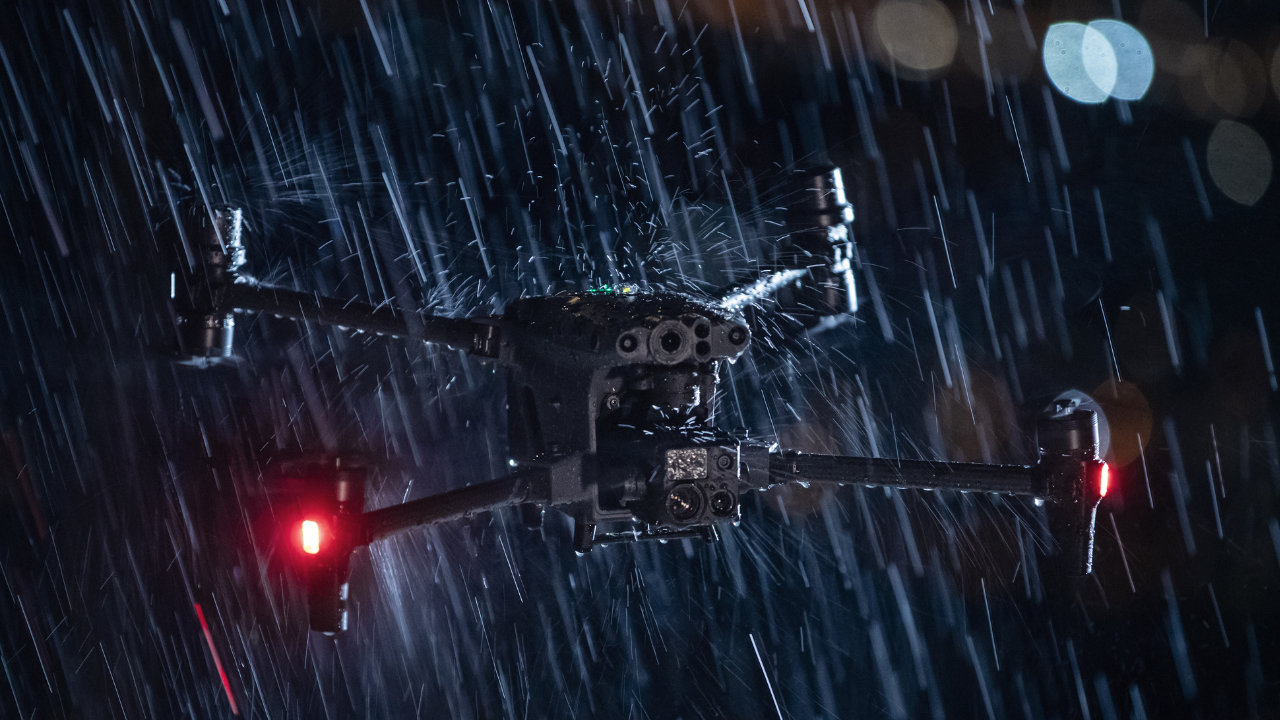
As an added bonus, the M30 Series' RC Plus comes with an IP54 rating.
In comparison, the M300 RTK has an IP45 rating - making it slightly less water-resistant compared to the M30 Series. Its accompanying Smart Controller Enterprise is not IP rated, although RC Plus compatibility is expected soon.
At the other end of the spectrum, the Mavic 3 Enterprise Series does not come with an IP rating, meaning it lacks the ability to handle wet weather compared to the others.
How important that is depends on the specific requirements of each operator/organisation.
Mavic 3 Enterprise Series | M30 Series | M300 RTK | |
IP Rating | No | IP55; RC Plus controller: IP54 | IP45; Check each payload for specific IP Rating) |
Operating Temperature | -10°C to 40°C | -20°C to 50°C | -20°C to 50°C |
Max Wind Speed | 12 m/s (during take-off and landing) | 15 m/s; 12 m/s during taking off and landing | 15 m/s; 12 m/s during taking off and landing |
Flight Time
The Mavic 3 Enterprise Series, M30 Series, and M300 RTK all boast impressive flight time.
Considering the small size of the drones, the Mavic 3 Enterprise Series can fly for up to 45 minutes, which is seriously impressive for such a compact aircraft. To put that into perspective, DJI's older lightweight solutions were not capable of such endurance, with the Mavic 2 Enterprise Advanced and Phantom 4 RTK achieving around 30 minutes of flight time.
With that perfect blend of power and portability, the M30 Series offers up to 41 minutes of flight time: Packing in plenty of endurance for a drone which comes with an impressive IP rating and top-class flight specs.
The flight time of the M300 RTK varies depending on which payload it is used with, but it is capable of achieving in excess of 40 minutes. Even when it is fully-loaded to its maximum take-off weight - a rather hefty 9kg with up to three payloads - it can fly for 31 minutes, which is a great return considering the multiple sensors on board.
The table below provides a summary of the flight times for each drone. Please note that, in the case of the M300 RTK, the table is not a definitive list, as the drone can be used with a wealth of payloads.
Mavic 3 Enterprise Series | M30 Series | M300 RTK |
Max flight time: 45 minutes With RTK Module: 42 minutes | Max Flight Time: 41 minutes | No payload: 55 minutes Z30: 46 minutes XT2: 45 minutes H20: 45 minutes P1: Up to 44 minutes H20T: 43 minutes L1: Up to 40 minutes Z30 + XT2: 39 minutes H20 + XT2: 39 minutes Max Load: 31 minutes |
Other Flight Performance Features
Some other flight performance features include that the M300 RTK and M30 Series have additional aircraft component redundancy; built in FPV camera (additional view point when utilising dual operators); and dedicated battery station for faster charging.
Mavic 3 Enterprise Series vs M30 Series vs M300 RTK
One of the biggest differences between the Mavic 3 Enterprise Series, M30 Series and M300 RTK is the price - and this could play a major part in deciding on your most suitable platform.
The Mavic 3 Enterprise Series represents great value: Cost-effective while packing plenty of power into its small frame.
The Mavic 3E launched at a price of just over £3,000, while the Mavic 3T was unveiled with a price tag of just shy of £5,000 (both prices not including accessories, like RTK Module). To put this into perspective, both drones are most cost-effective than the light and compact aircraft they look set to supersede - the P4 RTK and Mavic 2 Enterprise Advanced.

There are some sacrifices and some performance limitations compared to the M30 Series/M300 RTK, but they do represent great value, especially as entry-level aircraft and a quick-to-deploy solution.
The M30 Series is the mid-tier option, with the M30T, for instance, coming in at around the £11,000 mark. Yes, it is more costly than the Mavic 3 Enterprise Series, but that extra investment does bring additional benefits, such as powerful camera specs, high endurance, impressive IP rating, and a high-quality controller. In many respects, the M30 Series is an M300 RTK in a smaller and more portable frame - but without the versatility.
The M300 RTK is the most costly solution, with the drone alone weighing in at around £10,500. Adding payloads to the platform can quickly add up: But remember, you get plenty of bang for your buck, not only from a rugged, powerful and highly-versatile aircraft, but from the top-quality, industry-leading cameras and sensors which go with it.

Mavic 3 Enterprise Series vs M30 Series vs M300 RTK: Summary
The Mavic 3 Enterprise Series, M30 Series, and the M300 RTK are all quality commercial aircraft. But, because of their differences, they have a different user profile. Which one is right for you comes down to factors such as use case, budget and experience.
At one end of the spectrum is the Mavic 3 Enterprise Series. Lightweight, compact and packing in a multi-sensor payload, the Mavic 3E and Mavic 3T are extremely cost-effective platforms, particularly suited as entry-level aircraft and perfect for easy and rapid deployment. But there are some sacrifices to be made - including the lack of an IP rating, some performance limitations, and, in the case of the Mavic 3E, the camera is not quite as powerful as the M300's P1 for precision surveying.

Then there's the M30 Series, which ticks plenty of boxes. More costly than the Mavic 3 Enterprise Series, but more compact than the M300 RTK, the M30 Series packs power, performance and portability. While not a solution for surveying, it is a great option for inspection and public safety, especially with that impressive IP55 rating - coupled with its weather-proofed controller - plus effective payload and high endurance.

If there is one concession with the M30 Series, it's that it lacks the versatility of the M300 RTK - especially as it's not suited for precision surveying - but compatibility with modules such as loudspeakers and spotlights does ensure the M30 Series can be beefed out to help with mission efficiency and success in a public safety or inspection scenario.
Then there's the M300 RTK. DJI's flagship enterprise aircraft is the most costly, but its unrivalled versatility and ability to carry up to three payloads, coupled with powerful performance features, means it is a stellar choice.

Its versatility means that drone programmes can conduct an array of missions with one platform; Think public safety, where demand can vary between zoom and thermal cameras, to spotlights, speakers and surveying payloads for mapping crime scenes. And its payloads are industry-leading, with solutions like the P1 or L1 breaking new ground for drone surveying efficiency, accessibility and quality.
It is particularly suited to operators with experience, but that's not to say that entry-level pilots can't go straight for the M300 RTK.
We hope this blog has helped you to pick the best DJI Enterprise drone for your operations, but to discuss them in more detail, contact our enterprise drone team.
